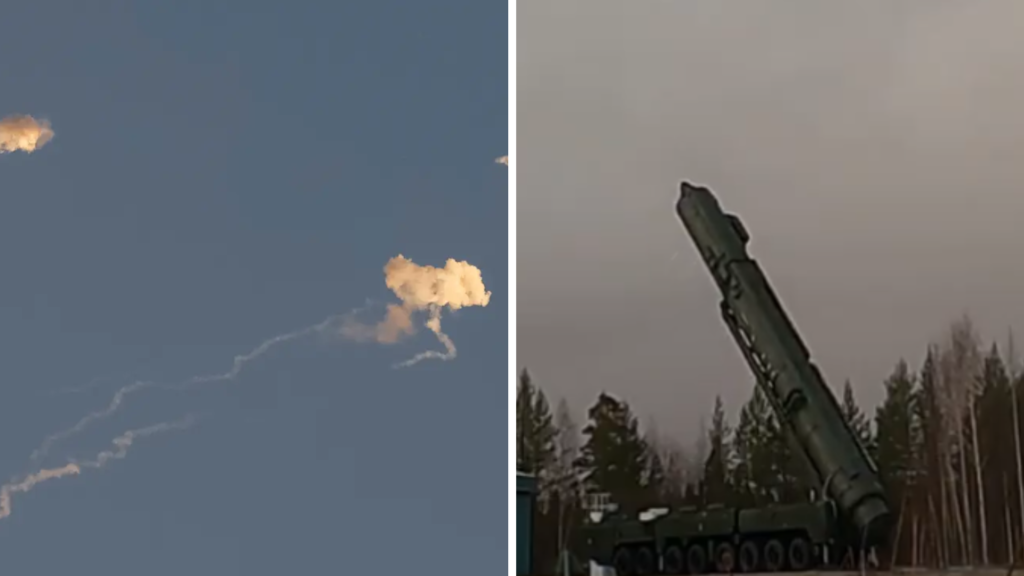
On Sunday, Russia unleashed a massive drone and missile assault on Ukraine, marking the most extensive attack in recent months.
The offensive, described by Ukrainian officials as the largest seen in over three months, specifically targeted the nation’s energy infrastructure, killing civilians and raising concerns about Moscow’s strategy ahead of the harsh winter season.
Ukrainian President Volodymyr Zelensky reported that Russia launched a staggering 120 missiles and 90 drones in the widespread attack.

The assault included various types of drones, notably Iranian-made Shahed models, as well as cruise, ballistic, and aircraft-launched ballistic missiles.
According to Zelensky, Ukrainian defense forces successfully intercepted and shot down 140 airborne threats during the attack, limiting the scale of destruction.
“The primary target of the enemy was our energy infrastructure across the country,” Zelensky stated in a Telegram post. “Despite our defensive efforts, there is significant damage to several facilities from missile hits and falling debris.
Tragically, in Mykolaiv, a drone strike killed two people and injured six others, including two children.”
The head of Kyiv’s City Military Administration, Serhii Popko, confirmed that this combined drone and missile attack was the most powerful Russia has launched in the past three months.
The assault represents a continuation of Russia’s strategy since its full-scale invasion of Ukraine in February 2022. Russian forces have repeatedly aimed at crippling Ukraine’s power infrastructure, leading to widespread emergency shutdowns and rolling blackouts across the country.
As explosions rocked various parts of Ukraine, including the capital Kyiv, the southern port city of Odesa, and multiple western and central regions, local authorities were quick to respond.

In Kyiv’s historic center, a five-story residential building caught fire due to missile debris, resulting in injuries to at least one individual, according to Popko.
The incident highlights the ongoing danger to civilian areas even as Ukrainian defense systems work to intercept incoming threats.
In Mykolaiv, a city in eastern Ukraine, the local governor Vitalii Kim confirmed that a drone strike resulted in the deaths of two civilians and injuries to six others, two of whom were children.
The attack in Mykolaiv underscores the human toll of Russia’s continued targeting of urban and residential areas in its military campaign.
One of the main objectives of the attack was to damage Ukraine’s power generation capacity. A thermal power plant operated by DTEK, a major private energy company, suffered significant damage, according to a statement from the company.
The ongoing assaults on energy infrastructure are part of a broader Russian strategy to disrupt Ukraine’s power supply, particularly as winter approaches.
The tactic aims to weaken Ukrainian morale and hinder the country’s ability to sustain its population and military operations during the colder months.
In response to the large-scale offensive, Poland’s armed forces issued a statement on X, noting that Polish and allied fighter jets were mobilized in Polish airspace due to the “massive” Russian attack on Ukraine.
The move was intended to enhance safety and security in Poland’s border regions, demonstrating the broader regional implications of Russia’s ongoing aggression.
The recent attack has intensified Ukrainian calls for Western allies to provide enhanced air defense systems. Ukrainian officials have consistently urged the international community to support their efforts in countering Russian assaults and facilitating swift repairs to damaged infrastructure.
The ability to bolster air defenses is seen as crucial in mitigating the impact of future strikes and ensuring the resilience of Ukraine’s critical infrastructure.
As winter looms, the latest escalation in Russian attacks signals a potential shift in Moscow’s tactics, focusing on debilitating Ukraine’s energy systems.
The humanitarian impact is already evident, with civilians facing the dual threat of missile strikes and the harsh realities of power outages during freezing temperatures.
With international support, Ukraine hopes to strengthen its defenses and maintain essential services as it braces for continued aggression.

